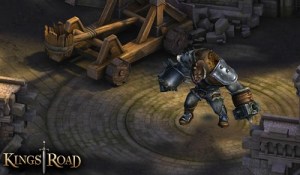GamesBeat: It seems like we may be in a stage here where mobile moves to a next generation, or something that’s a step above whatever you would call the first generation of mobile games. I don’t know if this is the period where triple-A does go over to mobile or console quality goes to mobile.
Richardson: When you look at what’s happening with tablets, the appetite for tablets in the west has been tremendous. Then you look at the data suggesting that nine out of 10 people that own a tablet in the United States are playing games on it. The people who own that hardware are a captive audience for games. Their spending rates and conversion for microtransaction-based games are multiples higher than on phones.
All of that says you have a ripe audience with the underlying memory and graphics and CPU hardware, plus the screen real estate, to deliver triple-A quality games. You’re already seeing some games start to be successful in the mobile space as they add more core game mechanics or IPs or themes that are more relevant to the traditional console audience. Higher production values and graphical fidelity matter, whether it’s CSR Racing or Clash of Clans or even Puzzle & Dragons, in the sense that there’s actually a traditional RPG ethos to that game.
GamesBeat: Is it difficult to figure out how high to shoot right now?
Richardson: Right or wrong, we decided to be very ambitious. We wanted to define the games we built by what we thought the audience wanted, not what was easy to do or currently successful. That meant high-end graphic fidelity. It also meant realtime synchronous multiplayer. When you talk about the next chapter of mobile gaming, one of the tenets of successful PC and console games has been being able to play in real-time with other people in action games. That hasn’t landed yet in mobile.
We’re doing exactly that across our entire portfolio. There are moments, as an early-stage company, where it feels like we’ve taken a lot of risk. Our games have taken longer to build and more money to build than we originally imagined. The flip side is that we think we’ll be where everyone wants to be before they get there. What’s interesting about tablets is that they’re always-connected devices. If we’re the first ones to deliver the great synchronous multiplayer experiences, we’ll get an outsized share of the rewards.
GamesBeat: Have you figured out whether the touch screen or the controller is the best option?
Richardson: I’ll use KingsRoad as an example. We got the game running on tablets earlier this year. We did it with the same design that runs on the web browser. What we found is that the translation of a mouse-driven control system to a touch screen was pretty straightforward. While you have to be thoughtful about the user interface and user experience, it was a pretty seamless transition. We know there’s not a ton of R&D that has to be done to solve that problem from the player’s perspective.
The flip side is Ballistic, a first-person shooter. You have two controls – where you move and where you shoot. It’s a tough problem, but it’s one that’s going to be overcome. The example I use is when the first Xbox came out and they showed Halo. Every first-person shooter player and almost every reporter said that you can’t play a shooter with a console controller. Now that seems silly. I think we’ll see the same kind of innovation and transition happen on the tablet.
GamesBeat: Could a single game be good and still run with the mouse, the touch screen, and the controller?
Richardson: You always want to be afraid of the lowest common denominator in design. We’re not going to do that. While all of our games cross PC and mobile devices, or will eventually, you have to be thoughtful about whether you have a game where the quality of the experience you give to the player can be delivered. Second, you have to take the time not to just port them, but to step back and say, “What is it about this device that it does well? How do we change the design to take advantage of that?”
In KingsRoad, for example, it’s great to use your finger like a mouse, but often you’re covering the screen with your hand while you do it. Where you place the UI needs to be different than in the PC space.
GamesBeat: Some of the speakers here have talked about the difference between mobile and console, in that you don’t see the same patterns in the top 50 as far as what the most popular games are. There’s an absence of brands on mobile. You don’t see sequels that are bigger than their predecessors. The problem becomes that you have to get lucky with each successive game. There’s not something like Call of Duty where you have a guaranteed hit.
Richardson: The challenge I’d present to people who speak from that perspective is, name a high-quality free-to-play game, loved by its players, that was well-designed as a game service that hasn’t succeeded. That’s a null set. We’re so early in the days of mobile that we haven’t seen anywhere near the maturity and consistency of quality products being brought that we’ve seen on consoles in the last 10 years. It’s still wide open.
Take Kabam with Kingdoms of Camelot. When they modified it for tablet, it wasn’t a runaway hit anymore on Facebook. It was probably on the back side of its life. But it’s been rejuvenated by finding a new audience. Is it the greatest free-to-play strategy game ever made? I don’t think even Kabam would say that. But it’s had outsized success. The point is that it’s really early. What’s driving the success of any individual title is generally that it’s first in a category at a reasonable level of quality.
I hear two things a lot. I hear a lot of complaints about the cost of player acquisition and I hear a lot of complaints about how the deck is stacked against you as a mobile developer or publisher, because it’s only the people who have an existing audience that are going to win.
In the first case, I say that if you make a good enough game, you’ll find that you’re buying a very low percentage of your installs. The cost of paying for those is going to be tiny when it’s amortized across all the organics you’re getting. So build a better game. Second, the better-quality games are winning. Build a better game.



